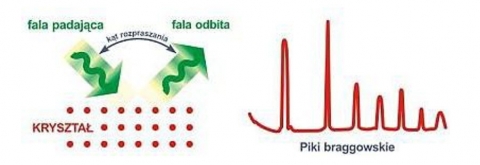Neutron beams from horizontal channels
(historical material; the experimental hall is currently being modernized, in which the new research equipment will be installed)
The use of horizontal beams in the MARIA reactor
Beams of neutrons emitted from the MARIA reactor are mostly used for the study of condensed matter. Five of the six currently available horizontal channels are equipped with devices that use neutron wave scattering effects (diffractometers, three-axis spectrometers). The physical basis of neutron scattering on crystal structures is illustrated in the diagram in Figure 1.
The ultra-low angle scattering diffractometer allows, among other things, to study the size of magnetic domains in amorphous, nanocrystalline and polycrystalline materials, as well as the influence of external factors such as temperature, mechanical stress and magnetic field on the size of these domains. The low-angle neutron scattering diffractometer is designed to study fine (1 nm 30 nm) inhomogeneities found in materials, while the high-resolution diffractometer is used, among others, to test the quality of metal single crystals. A diffractometer designed for the study of atomic and magnetic ordering can be used as a polarized neutron diffractometer.
Three-axis thermal neutron spectrometers are mainly used to study the collective movements of atoms (phonons) and magnetic moments (magnons) by the method of inelastic (coherent) scattering of neutrons. They are also used to study the electron energy levels in solid ions by inelastic (incoherent) neutron scattering.
One of the horizontal channels (H8) has a neutron and gamma radiography station. Radiography is a method of obtaining images of the interior of objects opaque to visible light. An object that completely absorbs light radiation can be nearly transparent to other types of radiation, such as X-rays, gamma rays, and neutrons. When image registration allows observation of the movement of the examined object, it is referred to as dynamic radiography. The dynamic neutron and gamma radiography station at the MARIA reactor uses neutron and gamma radiation generated in the reactor. Especially a lot of information is obtained through the use of neutrons. Currently, the applications of neutron radiography are focused on the study of static objects (internal structure of technical devices, detection of defects and heterogeneity of materials) and on the study of processes such as: water migration in porous materials, transport of liquids in filter beds, development of the plant root system, transport of crude oil in geological deposits, etc.














